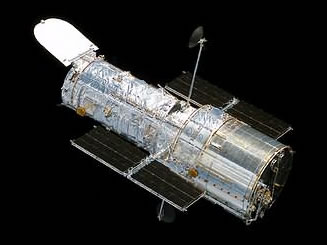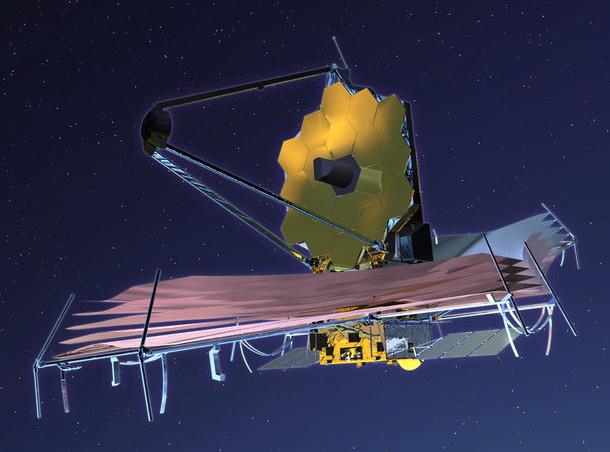The Most Distant Object Ever Confirmed
Interview with
This week, an international team of astronomers have confirmed the sighting of the most distant object ever seen. Ben Valsler spoke to Bristol University's Professor Malcolm Bremer to find out more.
 Malcolm - We were trying to identify extremely distant galaxies - in this case, a single galaxy - so that we can understand the very early stages of galaxy evolution. We're seeing this galaxy very early on in the history of the universe. We think therefore that it will tell us a lot about the early stages of how galaxies form and then evolve from the very small building blocks, such as this galaxy, into the larger galaxies like the Milky Way that we see today. And also, we are seeing this object at a particular time in the universe where there is a transition in the state of the gas that fills the universe, and we hope to be able to use this galaxy as a probe of that.
Malcolm - We were trying to identify extremely distant galaxies - in this case, a single galaxy - so that we can understand the very early stages of galaxy evolution. We're seeing this galaxy very early on in the history of the universe. We think therefore that it will tell us a lot about the early stages of how galaxies form and then evolve from the very small building blocks, such as this galaxy, into the larger galaxies like the Milky Way that we see today. And also, we are seeing this object at a particular time in the universe where there is a transition in the state of the gas that fills the universe, and we hope to be able to use this galaxy as a probe of that.
Ben - So if we come back to using the light from this galaxy as a probe to measure cosmology a bit later on, first of all, tell me a bit more about this galaxy. It's at what we think of as a very large red shift. Now what does that actually mean?
Malcolm - The red shift is a measure of how much the universe has expanded between the time that the photons were emitted by the galaxy, the radiation was emitted by the galaxy, and by the time we receive it. So a red shift of about an 8 ½ actually relates to the universe stretching by about 9 ½ times in linear dimension.
Ben - And what does that mean about how old the light actually is that's getting to us?
Malcolm - That actually means that the light was emitted about 600 million years after the Big Bang, and we are receiving it now, 13.1 billion years later. As well as the time it takes for the light to reach us, also, the light that we're interested in, which is originally emitted in the ultraviolet, we receive in the infrared because the expansion of the universe stretches all of the wavelengths of radiation coming from the galaxy by that much, by the time we actually receive the radiation.
 Ben - So, this new galaxy, is there anything particularly special about it that enables us to be able to see it, even though it's that far away?
Ben - So, this new galaxy, is there anything particularly special about it that enables us to be able to see it, even though it's that far away?
Malcolm - Well we hope not because what we're trying to characterise is the typical galaxy at these distances. The area of sky that was searched in order to find this object was searched using the Hubble Space telescope with a brand new infrared camera by other astronomers and they came up with a catalogue of objects that they believe to be at these great distances. Any one of them could be at the distance of this object or even slightly larger. So what we're actually hoping for is, this is a typical, very, very distant object. It just happens to be, because it takes an awful lot of effort, that this is the first one that we've confirmed to be this far away.
Ben - So you mentioned earlier that we can use it to probe cosmology really. As this light was emitted when the universe was very young, what can we determine about the state of the universe, just from this light?
Malcolm - Well, we expect that this object is observed as the hydrogen that fills the universe changed in state. Previous to this time, the hydrogen was cool, neutral material like the gas within the atmosphere of Earth. But then, at some point, something ionised that gas, and the effect of that is that the neutral hydrogen is opaque to much of the radiation that's emitted by these galaxies. But then as it gets ionised, charged effectively, and heated, it becomes transparent, and you can see the light escaping from these galaxies. It's an important step in the evolution of the universe. Knowing when it started, when this process ended, and what was causing the heating, the ionisation of the gas, is actually an important set of questions for astronomers. If we understand that, we understand an awful lot more about the early universe than we currently do.
Ben - So looking at the spectrum of light from this enormously distant galaxy - not only can we tell how far away it is, how much space is expanded, but by looking at the bits where this gas has absorbed some of that light in order to become ionised, we can also start to get an idea of the conditions that were around this galaxy.
 Malcolm - That's right and one thing that's peculiar about this galaxy is, although we've detected it and we've detected a signature of hydrogen within it, it doesn't seem to be luminous enough for itself to have converted the hydrogen that's around it on the larger scale, by itself, from neutral to ionised gas. We suspect therefore that what we're seeing is the signature of other galaxies that were either very bright before the time that we're actually seeing this galaxy, or just lots of smaller galaxies which are too faint to detect, which have actually done the excavation of the neutral hydrogen for that object. It on itself, I don't think would be able to actually carry out that process.
Malcolm - That's right and one thing that's peculiar about this galaxy is, although we've detected it and we've detected a signature of hydrogen within it, it doesn't seem to be luminous enough for itself to have converted the hydrogen that's around it on the larger scale, by itself, from neutral to ionised gas. We suspect therefore that what we're seeing is the signature of other galaxies that were either very bright before the time that we're actually seeing this galaxy, or just lots of smaller galaxies which are too faint to detect, which have actually done the excavation of the neutral hydrogen for that object. It on itself, I don't think would be able to actually carry out that process.
Ben - So that's evidence of other galaxies that are still too faint for us to see with current technology, but evidence that they must have been around in order to have that effect. What's the next step for us? How do we start to try and look for these galaxies?
Malcolm - These observations clearly push right at the limit of what we're able to do with current technology with both space based and ground based telescopes, but there will be technological improvements that will happen quite soon within astronomy. For example, we will get new instruments on the ground based telescopes that we're using at the moment. But also, over the next few years, there will be the successor to the Hubble Space telescope - this is the James Webb Space telescope. And then on the longer term, we hope to build extremely large telescopes in the ground with mirrors of size 30-40 metres, whereas the current typical size of a large telescope is an 8 metre mirror. That will be much, much more sensitive to these kinds of objects and hopefully we will not just be able to do the detection of these objects, but we will get much better spectra of them, and therefore be able to tell you much more about their physical state.










Comments
Add a comment